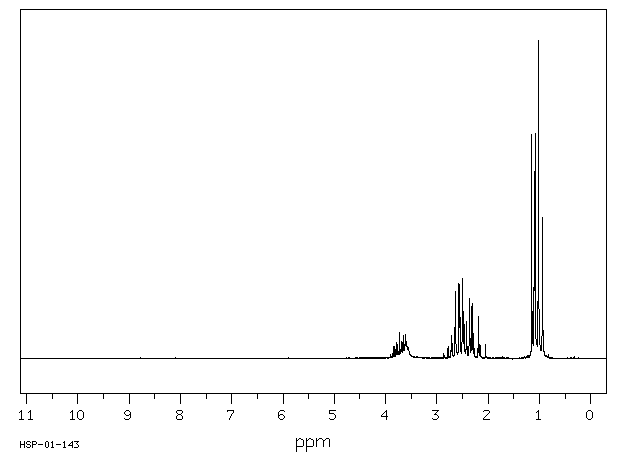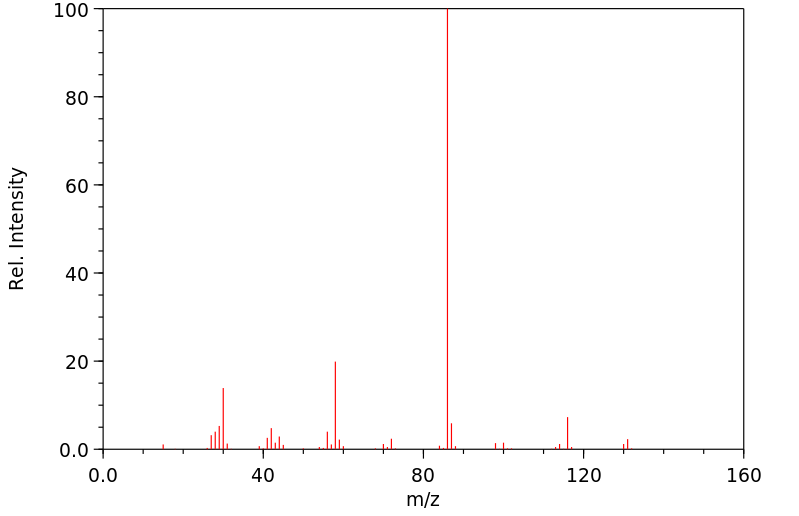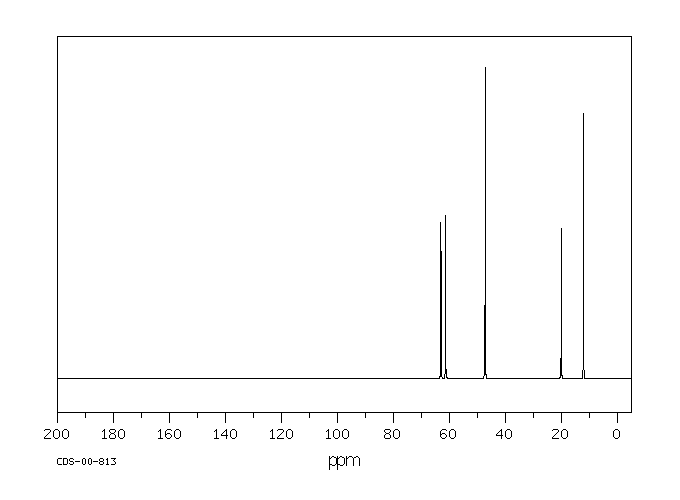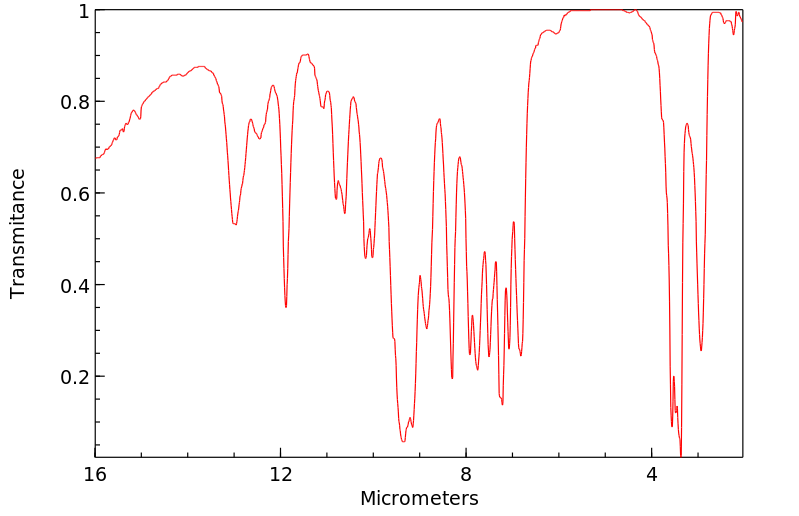1-二乙基氨-2-丙醇 | 4402-32-8
中文名称
1-二乙基氨-2-丙醇
中文别名
1-二乙氨基-2-丙醇;1-二乙胺基-2-丙醇;1-二乙基氨基-2-丙醇
英文名称
1-diethylamino-2-propanol
英文别名
N,N-diethyl-N-(2-hydroxypropyl)amine;N,N-diethyl-2-hydroxypropylamine;3-(N,N-diethylamino)propan-2-ol;1-Methyl-2-diethylaminoethanol;1-(Diethylamino)-2-propanol;1-diethylaminopropan-2-ol;1-(diethylamino)propan-2-ol
CAS
4402-32-8
化学式
C7H17NO
mdl
——
分子量
131.218
InChiKey
BHUXAQIVYLDUQV-UHFFFAOYSA-N
BEILSTEIN
——
EINECS
——
-
物化性质
-
计算性质
-
ADMET
-
安全信息
-
SDS
-
制备方法与用途
-
上下游信息
-
文献信息
-
表征谱图
-
同类化合物
-
相关功能分类
-
相关结构分类
物化性质
-
熔点:13.5 °C(lit.)
-
沸点:55-59 °C13 mm Hg(lit.)
-
密度:0.889 g/mL at 25 °C(lit.)
-
闪点:92 °F
-
稳定性/保质期:
在常温常压下保持稳定
计算性质
-
辛醇/水分配系数(LogP):0.7
-
重原子数:9
-
可旋转键数:4
-
环数:0.0
-
sp3杂化的碳原子比例:1.0
-
拓扑面积:23.5
-
氢给体数:1
-
氢受体数:2
安全信息
-
危险等级:3
-
危险品标志:Xi
-
安全说明:S24/25
-
危险类别码:R10,R36/37/38
-
WGK Germany:3
-
海关编码:2922199090
-
包装等级:III
-
危险类别:3
-
危险品运输编号:UN 1987 3/PG 3
-
危险性防范说明:P501,P240,P210,P233,P243,P241,P242,P264,P280,P370+P378,P303+P361+P353,P301+P330+P331,P363,P304+P340+P310,P305+P351+P338+P310,P403+P235,P405
-
危险性描述:H225,H314
-
储存条件:避光、存于通风干燥处并密封保存。
SDS
| Name: | 1-Diethylamino-2-Propanol 97% Material Safety Data Sheet |
| Synonym: | None known |
| CAS: | 4402-32-8 |
Synonym:None known
Section 2 - COMPOSITION, INFORMATION ON INGREDIENTS
| CAS# | Chemical Name | content | EINECS# |
| 4402-32-8 | 1-Diethylamino-2-Propanol | 97 | 224-537-7 |
Risk Phrases: 10 36/37/38
Section 3 - HAZARDS IDENTIFICATION
EMERGENCY OVERVIEW
Flammable. Irritating to eyes, respiratory system and skin.
Potential Health Effects
Eye:
Causes eye irritation. May cause chemical conjunctivitis and corneal damage.
Skin:
Causes skin irritation. May cause irritation and dermatitis. May cause cyanosis of the extremities.
Ingestion:
May cause gastrointestinal irritation with nausea, vomiting and diarrhea. The toxicological properties of this substance have not been fully investigated. Ingestion of large amounts may cause CNS depression.
Inhalation:
Causes respiratory tract irritation. The toxicological properties of this substance have not been fully investigated. Aspiration may lead to pulmonary edema. Vapors may cause dizziness or suffocation. Can produce delayed pulmonary edema. May cause burning sensation in the chest.
Chronic:
Effects may be delayed.
Section 4 - FIRST AID MEASURES
Eyes: Flush eyes with plenty of water for at least 15 minutes, occasionally lifting the upper and lower eyelids. Get medical aid.
Skin:
Get medical aid. Flush skin with plenty of water for at least 15 minutes while removing contaminated clothing and shoes. Wash clothing before reuse.
Ingestion:
If victim is conscious and alert, give 2-4 cupfuls of milk or water.
Never give anything by mouth to an unconscious person. Get medical aid. Do NOT induce vomiting. If conscious and alert, rinse mouth and drink 2-4 cupfuls of milk or water.
Inhalation:
Remove from exposure and move to fresh air immediately. If not breathing, give artificial respiration. If breathing is difficult, give oxygen. Get medical aid. Do NOT use mouth-to-mouth resuscitation.
Notes to Physician:
Treat symptomatically and supportively.
Section 5 - FIRE FIGHTING MEASURES
General Information:
As in any fire, wear a self-contained breathing apparatus in pressure-demand, MSHA/NIOSH (approved or equivalent), and full protective gear. Vapors may form an explosive mixture with air.
Vapors can travel to a source of ignition and flash back. During a fire, irritating and highly toxic gases may be generated by thermal decomposition or combustion. Will burn if involved in a fire. Use water spray to keep fire-exposed containers cool. Water may be ineffective. Material is lighter than water and a fire may be spread by the use of water. Containers may explode in the heat of a fire.
Flammable liquid and vapor. Vapors may be heavier than air. They can spread along the ground and collect in low or confined areas.
Extinguishing Media:
For small fires, use dry chemical, carbon dioxide, water spray or alcohol-resistant foam. For large fires, use water spray, fog, or alcohol-resistant foam. Use water spray to cool fire-exposed containers. Water may be ineffective. Do NOT use straight streams of water.
Section 6 - ACCIDENTAL RELEASE MEASURES
General Information: Use proper personal protective equipment as indicated in Section 8.
Spills/Leaks:
Absorb spill with inert material (e.g. vermiculite, sand or earth), then place in suitable container. Avoid runoff into storm sewers and ditches which lead to waterways. Clean up spills immediately, observing precautions in the Protective Equipment section. Remove all sources of ignition. Use a spark-proof tool. Provide ventilation. A vapor suppressing foam may be used to reduce vapors.
Section 7 - HANDLING and STORAGE
Handling:
Wash thoroughly after handling. Use with adequate ventilation.
Ground and bond containers when transferring material. Use spark-proof tools and explosion proof equipment. Avoid contact with eyes, skin, and clothing. Empty containers retain product residue, (liquid and/or vapor), and can be dangerous. Keep container tightly closed. Keep away from heat, sparks and flame. Avoid ingestion and inhalation. Wash clothing before reuse. Do not pressurize, cut, weld, braze, solder, drill, grind, or expose empty containers to heat, sparks or open flames.
Storage:
Keep away from heat, sparks, and flame. Keep away from sources of ignition. Store in a tightly closed container. Store in a cool, dry, well-ventilated area away from incompatible substances.
Flammables-area.
Section 8 - EXPOSURE CONTROLS, PERSONAL PROTECTION
Engineering Controls:
Facilities storing or utilizing this material should be equipped with an eyewash facility and a safety shower. Use adequate general or local explosion-proof ventilation to keep airborne levels to acceptable levels.
Exposure Limits CAS# 4402-32-8: Personal Protective Equipment Eyes: Wear appropriate protective eyeglasses or chemical safety goggles as described by OSHA's eye and face protection regulations in 29 CFR 1910.133 or European Standard EN166.
Skin:
Wear appropriate protective gloves to prevent skin exposure.
Clothing:
Wear appropriate protective clothing to prevent skin exposure.
Respirators:
A respiratory protection program that meets OSHA's 29 CFR 1910.134 and ANSI Z88.2 requirements or European Standard EN 149 must be followed whenever workplace conditions warrant respirator use.
Section 9 - PHYSICAL AND CHEMICAL PROPERTIES
Physical State: Liquid
Color: clear slightly yellow
Odor: None reported.
pH: Not available.
Vapor Pressure: Not available.
Viscosity: Not available.
Boiling Point: 55.0 - 59.0 deg C @ 13.00mmHg
Freezing/Melting Point: 13.5 deg C
Autoignition Temperature: Not available.
Flash Point: 33 deg C ( 91.40 deg F)
Explosion Limits, lower: Not available.
Explosion Limits, upper: Not available.
Decomposition Temperature:
Solubility in water:
Specific Gravity/Density: .8890g/cm3
Molecular Formula: C7H17NO
Molecular Weight: 131.22
Section 10 - STABILITY AND REACTIVITY
Chemical Stability:
Stable at room temperature in closed containers under normal storage and handling conditions.
Conditions to Avoid:
Incompatible materials, ignition sources, excess heat, strong oxidants.
Incompatibilities with Other Materials:
Oxidizing agents.
Hazardous Decomposition Products:
Nitrogen oxides, carbon monoxide, irritating and toxic fumes and gases, carbon dioxide, nitrogen.
Hazardous Polymerization: Has not been reported.
Section 11 - TOXICOLOGICAL INFORMATION
RTECS#:
CAS# 4402-32-8 unlisted.
LD50/LC50:
Not available.
Carcinogenicity:
1-Diethylamino-2-Propanol - Not listed by ACGIH, IARC, or NTP.
Section 12 - ECOLOGICAL INFORMATION
Section 13 - DISPOSAL CONSIDERATIONS
Dispose of in a manner consistent with federal, state, and local regulations.
Section 14 - TRANSPORT INFORMATION
IATA
Shipping Name: ALCOHOLS, N.O.S.*
Hazard Class: 3
UN Number: 1987
Packing Group: III
IMO
Shipping Name: ALCOHOLS, N.O.S.
Hazard Class: 3.3
UN Number: 1987
Packing Group: III
RID/ADR
Shipping Name: ALCOHOLS, FLAMMABLE, N.O.S.
Hazard Class: 3
UN Number: 1987
Packing group: III
Section 15 - REGULATORY INFORMATION
European/International Regulations
European Labeling in Accordance with EC Directives
Hazard Symbols: XI
Risk Phrases:
R 10 Flammable.
R 36/37/38 Irritating to eyes, respiratory system
and skin.
Safety Phrases:
S 7 Keep container tightly closed.
S 9 Keep container in a well-ventilated place.
S 16 Keep away from sources of ignition - No
smoking.
S 26 In case of contact with eyes, rinse immediately
with plenty of water and seek medical advice.
S 28A After contact with skin, wash immediately with
plenty of water.
S 33 Take precautionary measures against static
discharges.
S 37 Wear suitable gloves.
S 45 In case of accident or if you feel unwell, seek
medical advice immediately (show the label where
possible).
WGK (Water Danger/Protection)
CAS# 4402-32-8: No information available.
Canada
CAS# 4402-32-8 is listed on Canada's NDSL List.
CAS# 4402-32-8 is not listed on Canada's Ingredient Disclosure List.
US FEDERAL
TSCA
CAS# 4402-32-8 is listed on the TSCA inventory.
SECTION 16 - ADDITIONAL INFORMATION
N/A
上下游信息
-
上游原料
中文名称 英文名称 CAS号 化学式 分子量 —— 1-diethylamino-butan-2-ol 2683-58-1 C8H19NO 145.245 —— 1-diethylamino-but-3-en-2-ol 3141-84-2 C8H17NO 143.229 N-(2-羟丙基)-N,N-二乙胺N-氧化物 N-(2-hydroxypropyl)-N,N-diethylamine N-oxide 24294-42-6 C7H17NO2 147.217 —— 1-ethoxy-3-diethylamino-propan-2-ol 3141-82-0 C9H21NO2 175.271 -
下游产品
中文名称 英文名称 CAS号 化学式 分子量 2-(S)-N,N-二乙基-1-氨基-2-羟基丙烷 2-(S)-N,N-diethyl-1-amino-2-hydroxypropane 78778-91-3 C7H17NO 131.218 —— 1-diethylamino-butan-2-ol 2683-58-1 C8H19NO 145.245 —— 1-diethylamino-but-3-en-2-ol 3141-84-2 C8H17NO 143.229 —— 1-ethoxy-3-diethylamino-propan-2-ol 3141-82-0 C9H21NO2 175.271
反应信息
-
作为反应物:描述:参考文献:名称:Charpentier et al., Comptes Rendus Hebdomadaires des Seances de l'Academie des Sciences, 1951, vol. 232, p. 2232摘要:DOI:
-
作为产物:描述:参考文献:名称:Takahashi; Senda, Yakugaku Zasshi/Journal of the Pharmaceutical Society of Japan, 1949, vol. 69, p. 412摘要:DOI:
-
作为试剂:描述:perfluorophenyl 2-((tert-butoxycarbonyl)amino)acetate 、 Ts-Glu(OBzl)-OBzl 在 1-二乙基氨-2-丙醇 作用下, 以 氯仿 为溶剂, 反应 2.0h, 以90%的产率得到N-Boc-甘氨酰-L-谷氨酸二苄基酯参考文献:名称:One-Pot Liquid-Phase Synthesis of DSIP and 5-Phe-DSIP Using Fluoren-9-yl-methoxycarbonyl-Protected Amino Acid Pentafluorophenyl Esters摘要:Fmoc 保护的氨基酸五氟苯酯用于一锅液相合成 Delta 睡眠诱导肽 (DSIP) 和 5-Phe-DSIP。该方法的优点是操作简单、性能快、产量高、纯度高,这可能代表了一种改进的多肽合成方法。DOI:10.1055/s-1990-27032
文献信息
-
Synthesis and Antitumor Activity of 3-Methyl-4-oxo-3,4-dihydroimidazo [5,1-d][1,2,3,5]tetrazine-8-carboxylates and -carboxamides作者:Dan Liu、Jian-Guo Yang、Jie Cheng、Lin-Xiang ZhaoDOI:10.3390/molecules15129427日期:——Seventeen novel 3-methyl-4-oxo-3,4-dihydroimidazo[5,1-d][1,2,3,5]tetrazine-8-carboxylate and -carboxamide derivatives were synthesized and evaluated for their growth inhibition in seven human solid tumor and a human leukemia HL-60 cell lines. Compound IVa showed more activity than the other compounds and the positive control temozolomide. In the presence of 40 mg/mL of IVa, the survival rate of all tested tumor cells was less than 10%. Esters displayed more potent antitumour activity than amides and temozolomide against HL-60 cells. These compounds also exhibited considerably enhanced water-solubility.
-
[EN] TARGETED DELIVERY TO BETA CELLS<br/>[FR] ADMINISTRATION CIBLÉE À DES CELLULES BÊTA申请人:CHOUDHARY AMIT公开号:WO2018195486A1公开(公告)日:2018-10-25The disclosure includes zinc prodrugs for targeted delivery of therapeutic, diagnostic or imaging agents to β-cells and methods of use therefor. The disclosure also includes targeted delivery of small molecules to β-cells that stabilize and activate CRISPR effector proteins comprising at least one destabilization domain, to enable CRISPR-based genome editing and transcriptional activation or repression in β-cells.
-
Monosaccharide derivatives as anti-inflammatory agents申请人:Ranbaxy Laboratories Limited公开号:EP1953170A1公开(公告)日:2008-08-06The present invention relates to monosaccharide derivatives as anti-inflammatory agents. The compounds disclosed herein can be useful for inhibition and prevention of inflammation and associated pathologies including inflammatory, cancer, cardiovascular and autoimmune diseases such as bronchial asthma, rheumatoid arthritis, type-I diabetes, multiple sclerosis, allograft rejection, psoriasis, inflammatory bowel disease, ulcerative colitis, acne, atherosclerosis, pruritis or allergic rhinitis. Pharmacological compositions containing compounds disclosed herein and the methods of treating diseases such as bronchial asthma, rheumatoid arthritis, type-I diabetes, multiple sclerosis, cancer, cardiovascular diseases, allograft rejection, psoriasis, inflammatory bowel disease, ulcerative colitis, acne, atherosclerosis, pruritis or allergic rhinitis and other inflammatory and/or autoimmune disorders, using the compounds are also provided.
-
Recherches sur la formation et la transformation des esters LVI. Action de l'acide sulfurique sur les aminoalcools作者:Emile Cherbuliez、C. Chapalay、Sl. ?olak-Anti?、J. Marszalek、L. Vallet、J. RabinowitzDOI:10.1002/hlca.19640470754日期:——By heating an equimolecular mixture of an amino alcohol and H2SO4 during an appropriated time (half an hour to some hours) at 180–200°C under reduced pressure, the corresponding aminoalkyl sulfuric monoester is obtained in very good yield.
-
[EN] NOVEL PYRIDINE DERIVATIVES<br/>[FR] NOUVEAUX DÉRIVÉS DE PYRIDINE申请人:HOFFMANN LA ROCHE公开号:WO2014154612A1公开(公告)日:2014-10-02The invention relates to a compound of formula (I); wherein A and R1 to R4 are defined as in the description and in the claims. The compound of formula (I) can be used as a medicament.
表征谱图
-
氢谱1HNMR
-
质谱MS
-
碳谱13CNMR
-
红外IR
-
拉曼Raman
-
峰位数据
-
峰位匹配
-
表征信息
同类化合物
(乙腈)二氯镍(II)
(R)-(-)-α-甲基组胺二氢溴化物
(N-(2-甲基丙-2-烯-1-基)乙烷-1,2-二胺)
(4-(苄氧基)-2-(哌啶-1-基)吡啶咪丁-5-基)硼酸
(11-巯基十一烷基)-,,-三甲基溴化铵
鼠立死
鹿花菌素
鲸蜡醇硫酸酯DEA盐
鲸蜡硬脂基二甲基氯化铵
鲸蜡基胺氢氟酸盐
鲸蜡基二甲胺盐酸盐
高苯丙氨醇
高箱鲀毒素
高氯酸5-(二甲氨基)-1-({(E)-[4-(二甲氨基)苯基]甲亚基}氨基)-2-甲基吡啶正离子
高氯酸2-氯-1-({(E)-[4-(二甲氨基)苯基]甲亚基}氨基)-6-甲基吡啶正离子
高氯酸2-(丙烯酰基氧基)-N,N,N-三甲基乙铵
马诺地尔
马来酸氢十八烷酯
马来酸噻吗洛尔EP杂质C
马来酸噻吗洛尔
马来酸倍他司汀
顺式环己烷-1,3-二胺盐酸盐
顺式氯化锆二乙腈
顺式吡咯烷-3,4-二醇盐酸盐
顺式双(3-甲氧基丙腈)二氯铂(II)
顺式3,4-二氟吡咯烷盐酸盐
顺式1-甲基环丙烷1,2-二腈
顺式-二氯-反式-二乙酸-氨-环己胺合铂
顺式-二抗坏血酸(外消旋-1,2-二氨基环己烷)铂(II)水合物
顺式-N,2-二甲基环己胺
顺式-4-甲氧基-环己胺盐酸盐
顺式-4-环己烯-1.2-二胺
顺式-4-氨基-2,2,2-三氟乙酸环己酯
顺式-3-氨基环丁烷甲腈盐酸盐
顺式-2-羟基甲基-1-甲基-1-环己胺
顺式-2-甲基环己胺
顺式-2-(苯基氨基)环己醇
顺式-2-(苯基氨基)环己醇
顺式-2-(氨基甲基)-1-苯基环丙烷羧酸盐酸盐
顺式-1,3-二氨基环戊烷
顺式-1,2-环戊烷二胺二盐酸盐
顺式-1,2-环戊烷二胺
顺式-1,2-环丁腈
顺式-1,2-双氨甲基环己烷
顺式--N,N'-二甲基-1,2-环己二胺
顺式-(R,S)-1,2-二氨基环己烷铂硫酸盐
顺式-(2-氨基-环戊基)-甲醇
顺-2-戊烯腈
顺-1,3-环己烷二胺
顺-1,3-双(氨甲基)环己烷










